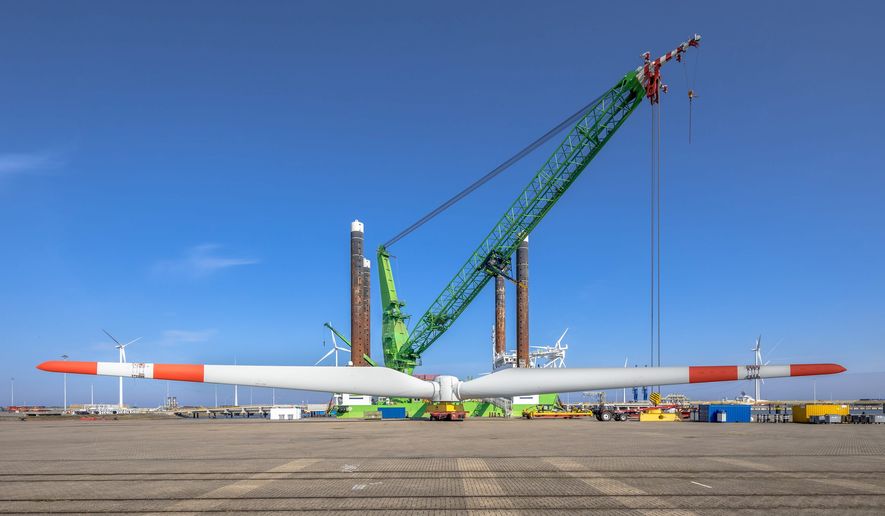OPINION:
In just over two-and-a-half years, we have seen a boon in American energy production. On the one hand, that should not be much of a surprise. As Republican nominee, Donald Trump promised as much. But on the other hand, the rise in American-generated power has not been as much from oil and gas as Trump supporters, and even some opponents, would expect.
No, part of this energy production growth has come from a very surprising source, one Mr. Trump didn’t spend much time talking about, but can now rightfully take credit for: Offshore wind energy.
It seems somewhat counterintuitive — even with an “all of the above” energy approach, offshore wind has typically been an afterthought. While the Bush administration started the ball rolling, and President Obama slowly started moving forward, it is the Trump administration that has pushed the boundaries.
Offshore wind has become a significant priority with a longer list of offshore projects from this administration than one might expect. Last December, an Interior Department auction of three offshore lease blocks brought in a record-shattering $405.1 million, yielding roughly $1,000 per acre for the federal government.
And it’s creating jobs.
For example:
The Empire Wind project south of Long Island will power over 500,000 homes and create 800 jobs.
The Sunrise Wind project, which was recently awarded a power purchase agreement in New York, will power over 500,000 homes and create over 1,600 jobs.
The Skipjack Wind Farm off the coast of Maryland will power 35,000 homes and create 1,400 jobs.
Revolution Wind off the Rhode Island Coast will power 270,000 homes and create 850 jobs.
This does not include projects such as the Coastal Virginia Offshore Wind project and the South Fork Wind Farm off the New York coast, which do not have firm job estimates yet. Nor does it include the Vineyard Wind project south of Martha’s Vineyard, which is still awaiting final approval from the Department of the Interior, and would create 800 megawatts of power and 3,600 jobs.
Most importantly, offshore wind jobs are being created across the country. Whether it’s from utilizing wind-turbine technicians from Colorado, shipbuilders from Louisiana or electricians from New Jersey, the offshore wind-supply chain stretches across the United States. With more than 18.6 gigawatts of offshore wind projected by 2030, offshore represents a new $70 billion industry, creating jobs and capital expenditure benefits for American businesses.
Offshore projects are never easy. In addition to the Washington red tape, which the Trump administration is cutting, offshore wind projects entail difficult engineering and construction challenges, and require due diligence within the local community. Local engagement means meaningful dialogue with the fishing community, who are concerned about the impacts of any such operation, creating mitigation funds, reducing, when necessary, the turbine footprint and carefully calibrating the distance between turbines to allow trawlers easy passage so that offshore wind and fisheries can thrive alongside each other.
Notably, the Vineyard Wind project would be the first ever to complete permitting through the One Federal Decision process, a showcase of President Trump’s initiatives to reduce regulatory burdens for business and encourage investment in our nation’s infrastructure. Vineyard Wind, once it gains final federal approval, will spur a private sector-driven energy revolution that provides clean, affordable energy and creates even more high-paying, long-term jobs.
As a vanguard for a new offshore energy industry, Mr. Trump can encourage similar projects that would provide clean, affordable and reliable energy — moving the country closer to energy independence and less dependent on many Americans’ current reality of Russian gas brought to the United States. Recent storms and blackouts, and warnings of more blackouts to come, show that increasing the reliability of America’s electricity grid is essential.
The rise of offshore wind is a trailblazing moment for the energy industry and for America. Creating clean, affordable and reliable wind energy off our coasts, while creating jobs in the process is a win-win, and the Trump administration deserves far more credit than it has been receiving. We have a chance to build great new offshore projects for America, and the Trump administration is leading the way.
Tim Charters is the vice president for government and political affairs at the National Ocean Industries Association. Aaron C. Smith is the president and CEO of the Offshore Marine Service Association. This article first ran online in The Washington Times Commentary section on Aug. 7, 2019.




Please read our comment policy before commenting.